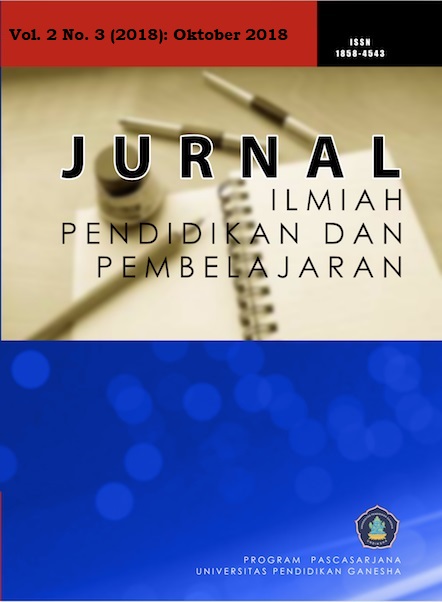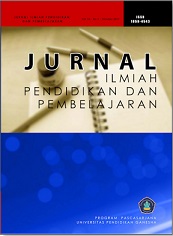KEEFEKTIFAN MEDIA SCRET OF SCREEN (SOS) MELALUI MODEL STUDENT TEAM ACHIEVEMENT DIVISIONS ( STAD) TERHADAP HASIL BELAJAR BENDA DAN SIFATNYA
DOI:
https://doi.org/10.23887/jipp.v2i3.16224Abstract
This study aims to determine the effectiveness of SOS media through the STAD model on learning outcomes of objects and the nature of third grade students of Ringin Kidul Elementary School when learning in learning completeness and student learning outcomes. This research is a quantitative study with a form of design. Pre Experimental Design which is a form of One Group Pretest-Posttest Design. The percentage of classical completeness initially 40% to 85%, the mastery of learning increased by 45%. The results of the analysis using the t test obtained value t = 8,568> t table = 1,725. From the results of the above research it can be concluded that SOS media through the STAD model is effective against the results of learning objects and the nature of third grade students of SDN Ringin Kidul. Key words: Effectiveness, Science, Scret Screen of Screen, STAD Model, Learning Outcome.References
Adi, I N. S. M. & N. N. Padmadewi, N. M. Ratminingsih.2017.” The Effect Of Stad Upon Students With Different Level Of Self Esteem Toward Reading Comprehension Of Eleventh Grade Students Of Sman 1 Kediri Tabanan In The Academic Year 2013/2014”. International Journal of Language and Literature Vol 1, No 3 (2017).
Al-Tabany, Trianto Ibnu Badar. 2014. Mendisain Model Pembelakaran Inovatif, Progresif, dan Kontektual. Jakarta: Prenadamedia Group
Arikunto, dan Suharsimi. 2010. Prosedur Penelitian Suatu Pendekatan Praktik.
Arikunto, dan Suharsimi. 2016. Dasar-Dasar Evaluasi Pendidikan. Jakarta: Bumi Aksara
Arsyad, Azhar. 2014. Media Pembelajaran. Jakarta: PT Rajagrafindo Persada
Dimyati dan Mudjiono. 2010. Belajar dan Pembelajaran. Jakarta: PT Rineka Cipta.
Indrawati, Ni Luh Gede Eka. 2017. ”Penerapan Model Pembelajaran Kooperatif Tipe Student Team Achievement Divisions (Stad) Untuk Meningkatkan Hasil Belajar Matematika Siswa Kelas VI SD No. 1 Sading Kecamatan Mengwi Kabupaten Badung Semester I Tahun Pelajaran 2016/2017”. Journal of Education Action Research Vol 1, No 2 (2017): August 2017.
Jayano,Dw. Md. R. Dwi & I Gst. Ngr. Japa I Md. Tegeh.2013.” Pengaruh Model Pembelajaran Kooperatif Tipe Stad Bermuatan Catur Pramana Terhadap Hasil Belajar Matematika Kelas V Sdn 1 Sangsit”. MIMBAR PGSD Undiksha Vol 1, No 1 (2013).
Jumadi. 2015. “Pengaruh Model Kooperatif Tipe STAD Menggunakan Media Animasi Terhadap Hasil Belajar Siswa IPA Kelas V Pada Materi Susunan Bumi Di SDN Pondok Geulumbang”. Jurnal Pendidikan Dasar. Vol.2, No.1: 1-10http://ejournal.stkipbbm.ac.id/index.php/pgsd/article/view/111. Diakses pada 15 Januari 2018
Kustandi, Cecep dan Sutjipto. 2016. Media Pembelajaran: Manual dan Digital. Bogor: Ghalia Indonesia.
Pujiono, Rudi.2017. ”Penerapan Model Pembelajaran Kooperatif Tipe Student Team Achievement Divisions (Stad) Untuk Meningkatkan Motivasi Dan Hasil Belajar Ipa Siswa Kelas V B Sdn 047 Tarakan”. Journal of Education Research and Evaluation Vol 1, No 4 (2017).
Rusdiani, Dini. 2012. Model Pembelajaran Langsung. Yogyakarta: Pustaka Pelajar
Samatowa, Usman. 2011. Pembelajaran IPA di Sekolah Dasar. Jakarta: PT Indeks
Sanaky, Hujair AH. 2013. Media Pembelajaran Interaktif-Inovatif. Yogyakarta: Kaukaba Dipantara
Slameto. 2010. Belajar dan Faktor-Faktor yang Mempengaruhi. Jakarta: PT Rineka Cipta.
Sudana, I Putu Ari & I Gede Astra Wesnawa.2017.” Penerapan Model Pembelajaran Kooperatif Tipe STAD Untuk Meningkatkan Hasil Belajar IPA”. Jurnal Ilmiah Sekolah Dasar Vol 1, No 1 (2017): Februari 2017.
Sudiarsini, Made, Gede Agung dan Parmiti. 2016. “Pengaruh Model Pembelajaran Kooperatif STAD Berbantu Media Visual Terhadap Hasil Belajar IPA Kelas V SD”. Jurnal Pendidikan Dasar. Vol. 4, No. 1:1-10https://ejournal.undiksha.ac.id/indexphp/JJPGSD/article/ view/7425. Diakses pada 5 November 2017
Suprijono, Agus. 2012. Cooperative Learning. Yogyakarta : Pustaka Pelajar
Sugiyono. 2015. Metode Penelitian Kuantitatif, Kualitatif dan R&D. Bandung: ALFABETA.
Wahyuni. 2014. “Pengaruh Penerapan Model Pembelajaran Kooperatif Tipe STAD Berbasis Interaksi Sosial Terhadap Hasil Belajar IPS Siswa Kelas V SD”. Univesitas Pendidikan Ganesha, Volume 2.
Downloads
Published
How to Cite
Issue
Section
License
Authors who publish with the Jurnal Ilmiah Pendidikan dan Pembelajaran (JIPP) agree to the following terms:
- Authors retain copyright and grant the journal the right of first publication with the work simultaneously licensed under a Creative Commons Attribution License (CC BY-SA 4.0) that allows others to share the work with an acknowledgment of the work's authorship and initial publication in this journal.
- Authors are able to enter into separate, additional contractual arrangements for the non-exclusive distribution of the journal's published version of the work (e.g., post it to an institutional repository or publish it in a book), with an acknowledgment of its initial publication in this journal.
- Authors are permitted and encouraged to post their work online (e.g., in institutional repositories or on their website) prior to and during the submission process, as it can lead to productive exchanges, as well as earlier and greater citation of published work. (See The Effect of Open Access)










